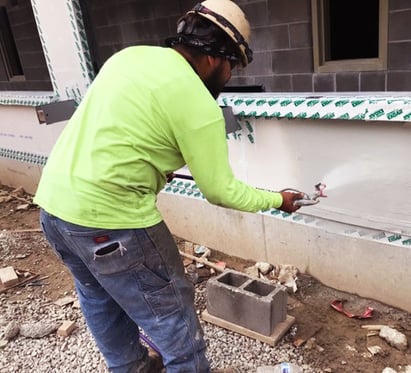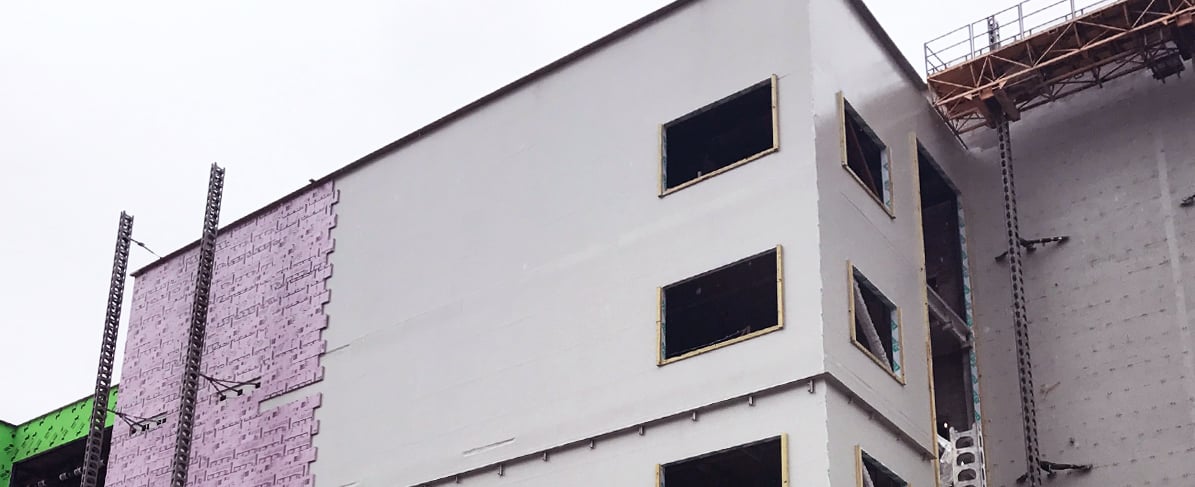Buildings leak. But what if they didn’t have to? For air barriers, a building material notoriously susceptible to moisture infiltration, there is no industry-approved guide specification for the performance of the assembly. In this two-part series, we will go back to the basics of air barriers and discuss system testing options to help improve product selection. Click here to skip to Air Barrier Testing Part 2: Adapting to Measure Assemblies.
Vulnerability in Air Barriers
Air barriers are intended to block air and moisture from getting into the building. But frequent testing and thermographic imaging shows that one common source of building leaks is at or near air barrier failures. Improper lapping and detailing of terminations, incompatible products, and lack of adhesion are just a few of the potential culprits.
Of course, many of these issues can be prevented by prioritizing proper sequencing of trades, quality installation, project-specific testing, and training. That extra time and coordination can prevent a long, expensive investigation during which the façade is removed from the building in order to search for the source of the problem.
Before we dive into the testing specifics, here are some key definitions to remember:
- Air Barrier Materials
- Building material with an air permeance not greater than 0.20 L/(sm²) at 75 Pa that is designed and constructed to provide the primary resistance to airflow.
- Various technologies available including fluid-applied, sheet-applied, or factory-bonded products.
- Air Barrier Component
- The pre-manufactured elements such as windows and doors installed within the wall.
- Air Barrier Accessories
- Products designed to maintain air tightness between air barrier materials, air barrier assemblies and air barrier components, to fasten them to the structure of the building, or both.
- Includes sealants, tapes, backer rods, transition membranes, nails/washers, ties clips, staples, strapping, and primers.
- Air Barrier Assembly
- Combination of air barrier materials and air barrier accessories to act as a continuous barrier to the movement of air through the environmental separator.
- Air Barrier System
- The collection of air barrier assemblies.

Taking this one step further – connecting the air barrier system to the other components of the building enclosure is key to long-term performance. This means appropriate transitions to the waterproofing, fenestrations and penetrations, balconies and decks, and roofing systems. These connections must be specified, completed properly, and further discussed in the preconstruction meeting so that all stakeholders know how they will be made and who will be responsible.
4 Requirements of an Air Barrier
It may seem straightforward, but here are the four industry-recognized requirements of an air barrier:
- Air impermeable – As its name suggests, it must be able to control the flow of air.
- Continuous – An air barrier and its accessories must create a continuous surface, securely connecting them to the other adjacent building components
- Structural integrity – Once the building is ready for use and is under either positive or negative pressure, it will stay adhered so that it can perform sufficiently.
- Durable – The materials are capable of performing as intended over the life of the building.
Air Barrier Testing
Below are the five existing material tests to validate the above requirements of an air barrier:
- Air permeance
- Measured by the air leakage test, ASTM E2178- Standard Test Method for Air Permeance of Building Materials
- Purpose: To determine the air permeance of a material and its suitability as a component of an air retarder system.
- Industry Recognized Requirement: 0.004 cfm/ft2 @ 1.57 lb/ft2 max
- Water resistance
- Measured by AATCC 127-08- Water Resistance: Hydrostatic Pressure Test
- Purpose: To determine water resistance of the material to the penetration of water under hydrostatic pressure.
- Industry Recognized Requirement: Minimum of 22 in./5 hr.
- Self-sealability
- Measured by ASTM D1970, Section 8.9- Standard Specification for Self-Adhering Polymer Modified Bituminous Sheet Materials Used as Steep Roofing Underlayment for Ice Dam Protection
- Purpose: To determine if the material can perform when penetrated with a smooth roofing nail under hydrostatic head pressure.
- Industry Recognized Requirement: Typical minimum requirement of membranes is 200%.
 Pull adhesion
Pull adhesion
- Measured by ASTM D4541- Standard Test Method for Pull-Off Strength of Coatings Using Portable Adhesion Testers
- Purpose: To determine the pull off strength of the material to the substrate.
- Industry Recognized Requirement: 16 psi
- Crack bridging
- Measured by ASTM C1305- Standard Test Method for Crack Bridging Ability of Liquid-Applied Waterproofing Membrane
- Purpose: To determine the strength of a material with respect to its ability to bridge a substrate crack and withstand repeated movements.
- Industry Recognized Requirement: Pass/Fail
All air barrier technologies can be effective with proper compatibility and installation. It is important to understand the key requirements of an air barrier so that you can have confidence in your chosen system’s longevity throughout the life cycle of your building. In our next blog post, we will explore how to adapt the above material tests to enable them to measure assemblies.







